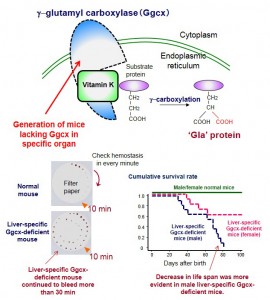Liver-specific disruption of vitamin K function Useful model mouse to clarify unknown vitamin K function

Vitamin K, which is contained in brightly colored vegetables and fermented soy beans, is clinically used to prevent hemorrhage in the brain of newborn infants and to treat osteoporosis in the elderly or as the side effect of glucocorticoids. In addition, epidemiological studies suggest that lack of vitamin K is associated with higher risk of arteriosclerosis, dementia, and some kinds of malignancies.

© Kotaro Azuma and Satoshi Inoue.
γ-glutamyl carboxylase (Ggcx) is an enzyme on the endoplasmic reticulum. Ggcx is responsible for a protein modification process called γ-carboxylation and the modified protein is called the ‘Gla’ protein. Vitamin K is required for this process. The mice lacking Ggcx in the liver displayed bleeding diathesis and their life span was shorter than normal mice. The decrease of life span was more evident in male mice.
Vitamin K mainly functions as a co-enzyme for γ-glutamyl carboxylase (Ggcx) playing a crucial role in modification and activating of proteins including coagulation factors in the liver. Considering that more than ten kinds of protein throughout the body were found to be substrates of Ggcx, vitamin K is supposed to have some biological function in organs other than the liver. However, analysis of these various roles of vitamin K in animal models has been hampered by the fact that Ggcx knockout mice die shortly after birth due to severe bleeding.
Prof. Satoshi Inoue of the Department of Anti-Aging Medicine, Dr. Kotaro Azuma of the Department of Geriatrics in the University of Tokyo Hospital (affiliation at the time of the study), and Dr. Kazuhiro Ikeda of the Research Center for Genomic Medicine in Saitama Medical University generated mice lacking Ggcx only in the liver and observed bleeding diathesis in collaboration with Osaka University and Kobe Pharmaceutical University. They also obtained the intriguing result that female mice lived longer than male mice on the condition that they did not get pregnant. This research demonstrates that it is possible to create model mice where vitamin K function is disrupted in specific organs, opening up the possibility to clarify the various roles of vitamin K throughout the body.
This research was supported by Grant-in-Aid from MEXT and JSPS and was published in PLOS ONE on 10 February 2014.
Department release/press release [pdf] (Japanese)
Paper
Azuma K, Tsukui T, Ikeda K, Shiba S, Nakagawa K, Okano T, Urano T, Horie-Inoue K, Ouchi Y, Inoue S,
“Liver-specific γ-Glutamyl Carboxylase-Deficient Mice Display Bleeding Diathesis and Short Life Span”,
PLoS One,Online Edition: 2014/2/10 (Japan time) , doi: 10.1371/journal.pone.0088643.
Article link
Links
Department of Anti-Aging Medicine, The University of Tokyo Hospital (Japanese)
Department of Geriatric Medicine, The University of Tokyo Hospital (Japanese)







